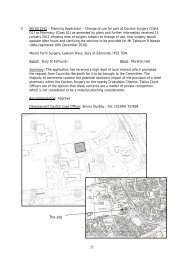St Edmundsbury Core Strategy (December 2010)
St Edmundsbury Core Strategy (December 2010)
St Edmundsbury Core Strategy (December 2010)
Create successful ePaper yourself
Turn your PDF publications into a flip-book with our unique Google optimized e-Paper software.
8.9 The study also considered the infrastructure/environmental capacitythresholds which might limit the scope for housing growth beyond existingRegional Spatial <strong>St</strong>rategy proposals, most immediately for the period to 2031, andexamined how these might be overcome.8.10 In particular the study considered how development in the area might beaccommodated and identified specifically:What infrastructure will be needed to support this?When it will be needed?How can it be funded?What are the options?What are the associated risks?Where relevant, how can long term future maintenance be secured?8.11 Whilst key stakeholders were involved throughout the production of the <strong>Core</strong><strong>St</strong>rategy through a series of topic based focus groups, the outputs from thesemeetings were supplemented through the consultant led engagement withstakeholders during the development of the infrastructure appraisal. This hasensured a robust outcome that provides certainty of the need for infrastructureand the potential costs of provision.Outcomes of the <strong>St</strong>udy8.12 The Infrastructure and Environmental Capacity Appraisal identified nocapacity issues that could not be overcome through mitigation measures. The keyinfrastructure capacity issues and risks of non delivery to improve capacity are setout in a series of settlement tables in Appendix 6, detailing towns and Key ServiceCentres as established in Policy CS4. These tables also set out the fundamental,essential and required infrastructure for each of these settlements along withtipping points (number of new homes required before a certain level ofinfrastructure is required). Finally the tables set out a broad estimation of how therequired infrastructure provision will be met. All of the information in the tables issummarised from the Infrastructure and Environmental Capacity Appraisal which,along with the <strong>Core</strong> <strong>St</strong>rategy Infrastructure Delivery Plan, should be be readalongside these tables.8.13 The tables are accompanied by a visual representation of the figures andanalysis contained within the main report. These figures are not designed to beused as a definitive identification of what infrastructure is required at each level ofgrowth but does provide an overview of the likely types of infrastructure required.8.14 When assessing the requirement for infrastructure associated with housinggrowth, in a policy and delivery climate where resources are limited, there is aneed to focus on what is most needed, and to make choices and trade-offsbetween the costs and benefits associated with different requirements. This isparticularly relevant at a time when public finances are likely to be constrained,and where development values are pressured by a difficult market.8.15 For this reason, the <strong>St</strong>udy has sought to categorise different infrastructuretypes based on a high level view of its necessity in bringing forward development.It seeks to distinguish between:a „Fundamental‟ infrastructure required to overcome development„showstoppers‟. This category includes infrastructure that is so fundamental togrowth taking place that without it development (or occupancy of80
















